Something is going on with the world’s great lakes.
Slowly but surely, some of them appear to be vanishing or have already almost completely disappeared.
Today, water around the globe is disappearing faster than ever. Here are ten bodies of water that are already dry, or disappearing at an unprecedented rate.
OWENS LAKE, UNITED STATES
The unquenchable thirst of Los Angeles is to blame for the dust bowl now known as Owens Valley.
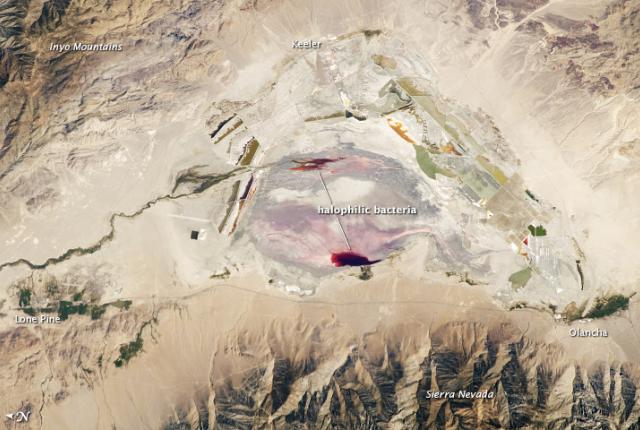 Owens Lake drying up. via Geochange
Owens Lake drying up. via GeochangeBefore drying up in 1926, Owens Lake covered about 108 square miles in California near the border with Nevada. But in 1913, the Los Angeles Department of Water and Power diverted the Owens River into the LA Aqueduct.
ARAL SEA, KAZAKHSTAN
Once an oasis in central Asia and the fourth largest body of fresh water in the world, the Aral Sea began losing volume in the 1960s. In an attempt to irrigate crops in the deserts of what is now Uzbekistan, the USSR had started diverting water from the Aral’s feeder rivers, the Amu Darya and Syr Darya, in the ’40s.
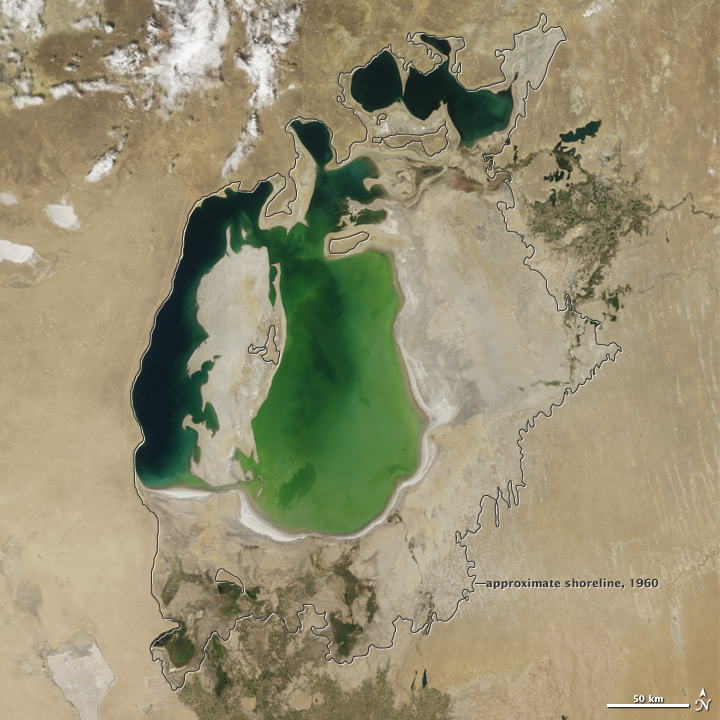 Aral Sea in 2000 via EO
Aral Sea in 2000 via EOBy 1986, the lake volume decreased to the point of becoming four distinct bodies of water. Today, it can claim only about 10 percent of its former surface area of 26,300 square miles. By volume, the lake has lost an estimated 167 billion gallons of water, more than the entire volume of Lake Erie.
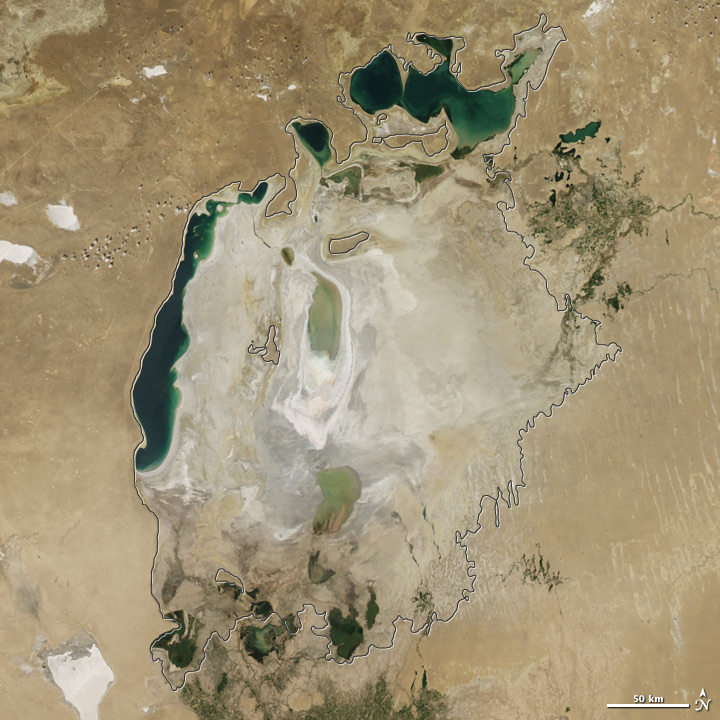 Aral Sea in 2015 via EO
Aral Sea in 2015 via EOStill, there is some hope the Aral Sea will persist. In 2003, Kazakhstan, Kyrgyzstan, Tajikistan, Turkmenistan, and Uzbekistan joined together to build the Kokaral Dam.
By 2007, the structure had slowed the drainage enough to increase water levels in the northern body by about 40 meters.
DEAD SEA, MIDDLE EAST
At the lowest point on Earth, the Dead Sea is slowly wasting away. The last 30 years have seen a dramatic decrease in lake size as quickly as 3 feet per year.
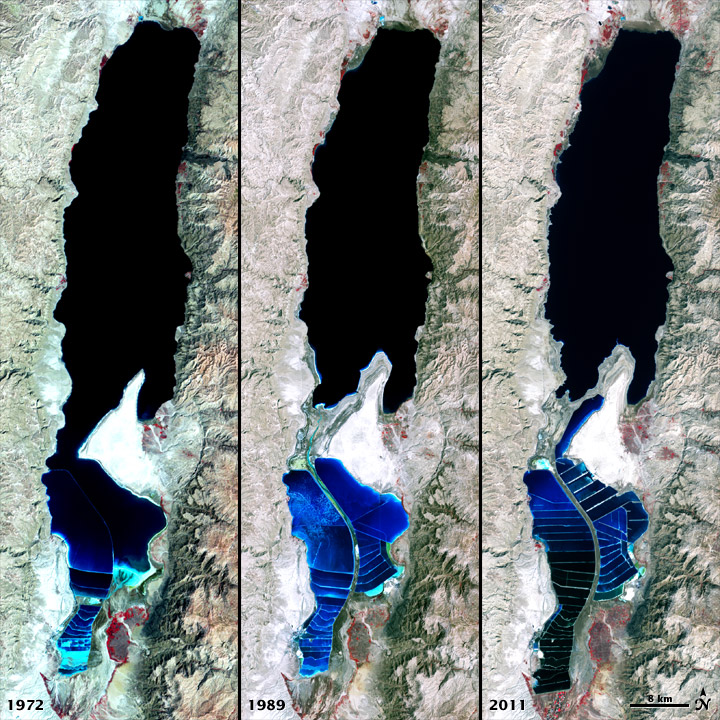 Evolution of the Dead Sea from 1972 to 2011. via EO
Evolution of the Dead Sea from 1972 to 2011. via EOTwo distinct bodies of water now characterize the Dead Sea. The southern portion is home to ponds that are used to extract salts and other minerals. This part is eaten by giant sinkholes. The northern body is still a beacon for tourists.
To slow down the drying of the Dead Sea, Israel, Jordan, and Palestine have agreed to a plan to pump in about 53 billion gallons of water per year from the Red Sea – more than 100 miles away.
4. LAKE FAGUIBINE, MALI
In its heartier days, Lake Faguibine in Mali was one of the largest lakes in West Africa, at about 230 square miles. But by 1990, droughts had completely dried the lake, forcing residents to seek subsistence from other resources.
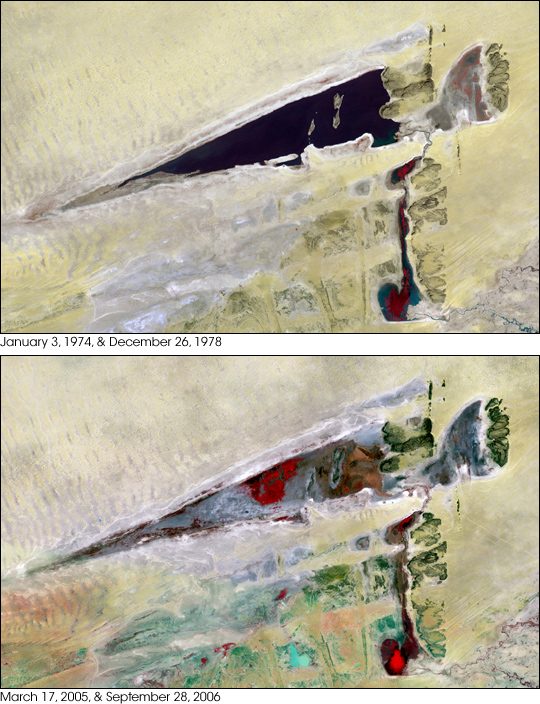 Water level evolution of the Faguibine lake disappearing between 1978 and 2006. via EO
Water level evolution of the Faguibine lake disappearing between 1978 and 2006. via EOA return of rains in the last 15 years has added about six percent of former surface area to Faguibine, but long-term restoration appears impossible.
LAKE ASSAL, DJIBOUTI
With temperatures reaching a scorching 125 degrees Fahrenheit during the summer, the evaporation of Lake Assal in Djibouti is an unavoidable reality.
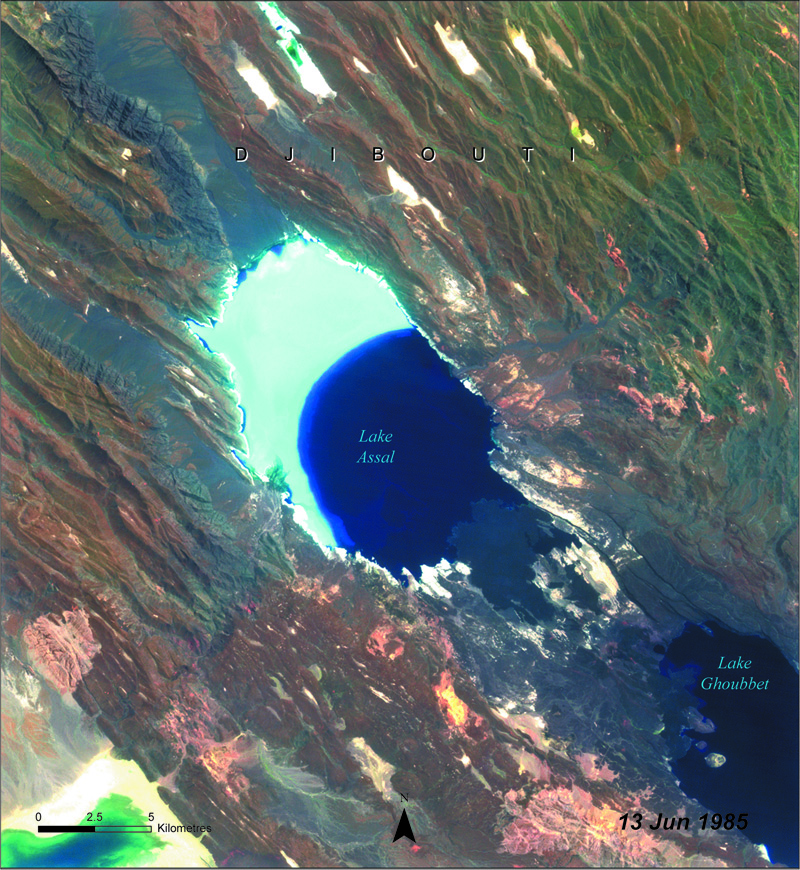 Assal lake disappearing in 1985 via UNEP
Assal lake disappearing in 1985 via UNEPHoused in a volcanic crater, the body of water was likely separated from the Gulf of Aden, and the greater Indian Ocean, by lava flows. In such harsh conditions, Assal sees little rainfall runoff to feed the lake. Instead, its volume is replenished through subsurface water flow from the nearby gulf.
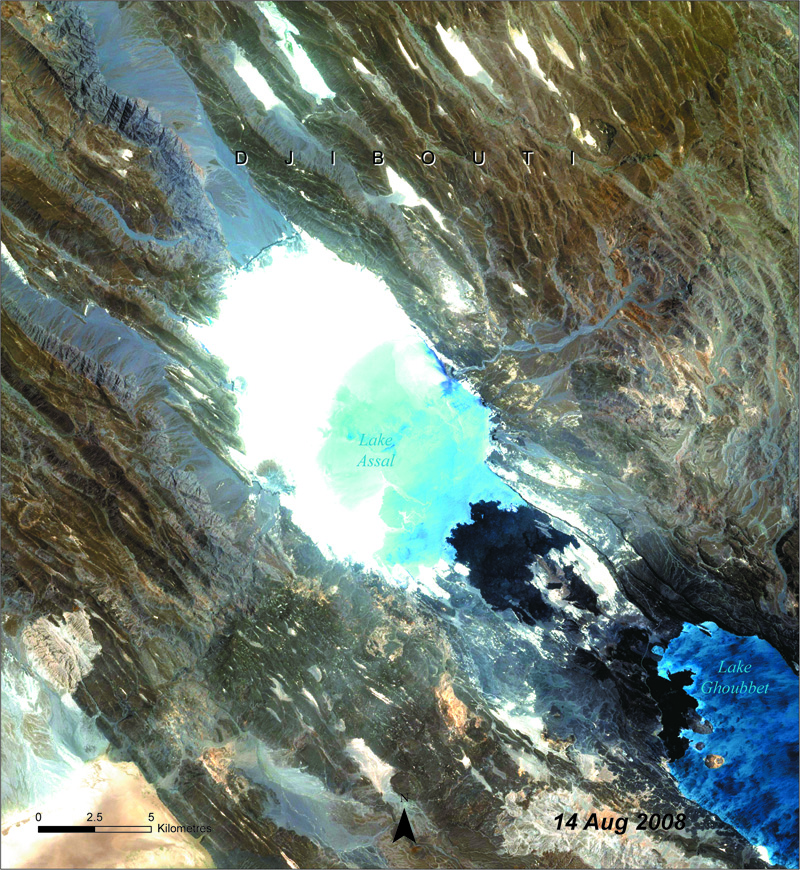 Assal lake disappearing in 2008 via UNEP
Assal lake disappearing in 2008 via UNEPOne of just a few lakes that has not shrunk due to water diversion, Assal is still an important natural resource for the local economy. The lake is 10 times more saline than seawater, and its salt is harvested for distribution across Africa and Europe.
LAKE CHAD, CHAD/NIGER/NIGERIA/CAMEROON
The Lake Chad basin in central Africa is an “ecological catastrophe” according to the United Nations. The lake’s main feeder, the Chari River, was diverted to provide irrigation for farmers in different regions.
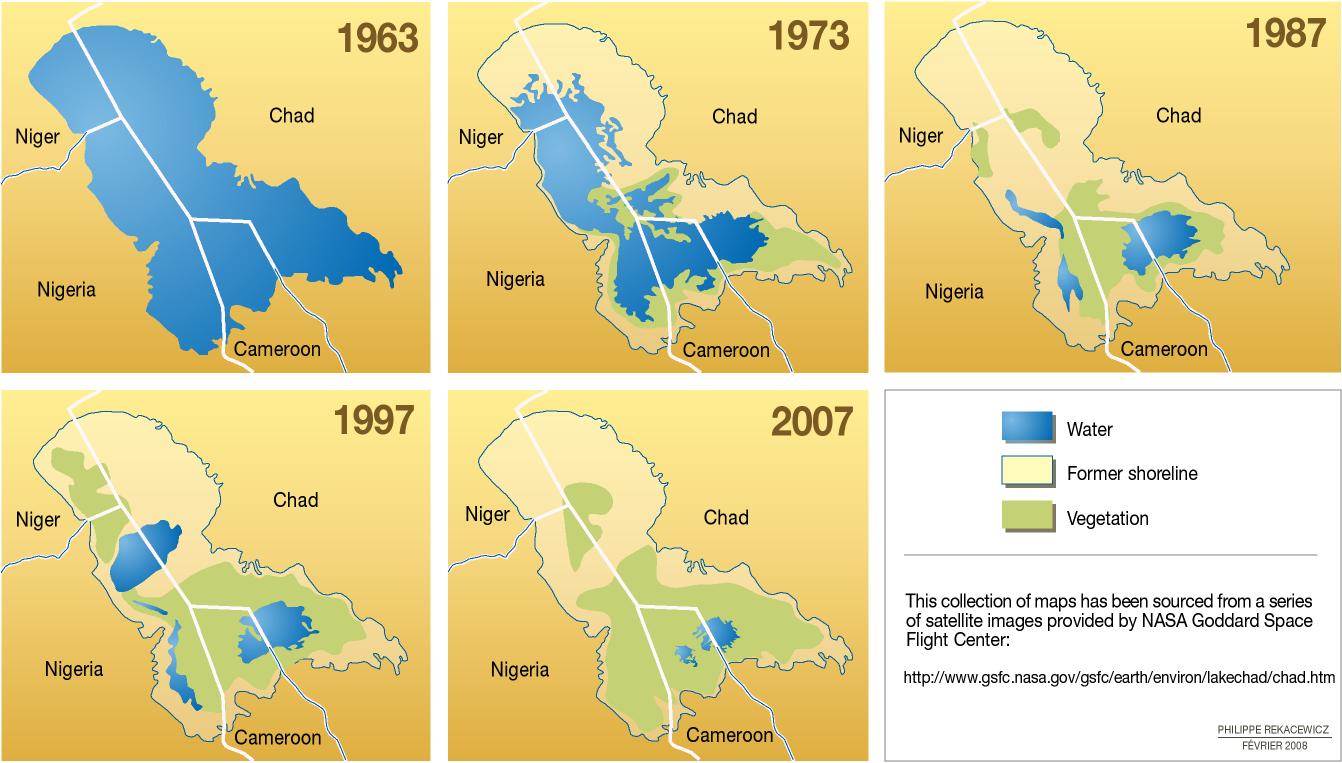 Evolution of water level in disappearing Lake Tchad. via UNEP
Evolution of water level in disappearing Lake Tchad. via UNEPBetween 1963 and 2001, the lake shrank by 95 percent to just 580 square miles; it had previously measured more than 10,000 square miles. With the lack of water and marshes, dust chokes the area, beginning the process of dune formation and the desertification of a once lush habitat.
Chad, Nigeria, Cameroon, Niger, and the Central African Republic hope to pump water from the Congo River north toward the Chari, but the effects of diversion toward Chad remain unclear.
LAKE URMIA, IRAN
With six dams capturing a majority of water from 11 rivers that once fed the salt lake, Lake Urmia in northern Iran is evolving from a luxury vacation destination into a cracked salt bed.
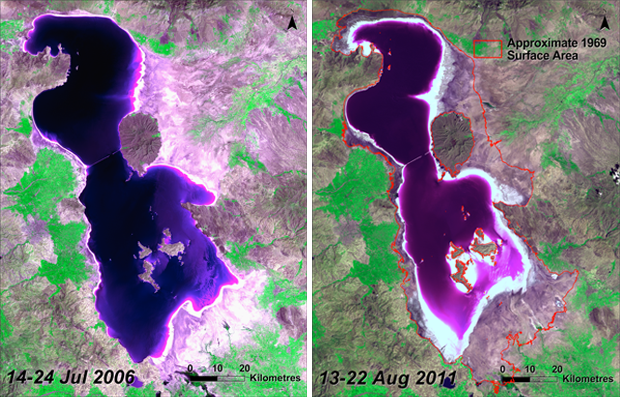 Lake Urmia has lost more than 40% of this volume within 45 years. Via UNEP
Lake Urmia has lost more than 40% of this volume within 45 years. Via UNEPAs big as 2,000 square miles, the lake was once among the largest in the Middle East. Today, it covers just under 40 percent of that area.
Although energy and food production has benefited from the damming of the rivers, many environmentalists fear the long-term result of water diversion could be a nearly dry lakebed like the dustbowl of the Aral Sea.
POYANG LAKE, CHINA
China’s Lake Poyang the country’s largest freshwater lake. In January 2014, it receded so far to reveal an ancient stone bridge that had been submerged for 400 years. In 2012, during one of the country’s worst droughts, China’s official Xihua News Agency reported the lake had reached a new record low of 7.95 meters (about 28 feet).
Local authorities at that time even went to the extreme measure of air-dropping millet, corn, and shrimp for the hundreds of thousands of migratory birds that feed at Poyang. And while mother nature is one of the main culprits, China’s disastrous Three Gorges Dam has also played a big role in withholding water from the lake.
Damming the lake, which is situated in the middle of the Yangtze River, has been proposed to restore lake levels for both economic and ecological benefits—but no imminent plans are in place, as the effects of the drought are forgotten during the wet season.
LAKE CHAPALA, MEXICO
The fate of Mexico’s largest lake, Chapala, is bad. Historically averaging about 700 square miles in surface area, Chapala experienced its first major crisis in 1955. A combination of drought and diversion saw the water level dip by about 7 percent, enough to wreak havoc on hydraulic electricity generation for the town of Guadalajara.
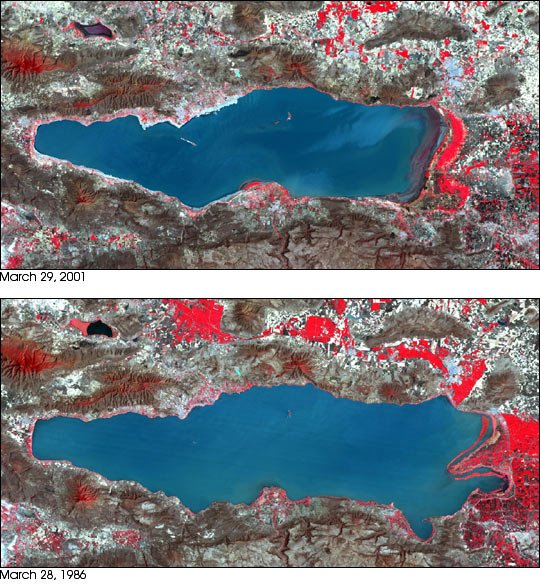 The largest lake in Mexico is disappearing. Via EO
The largest lake in Mexico is disappearing. Via EOAlthough the lake rebounded throughout the later part of the century, by 2001 more than 25 percent of the lake’s surface area had disappeared. Water levels nearly matched those of the crisis in 1955.
GREAT LAKES, UNITED STATES/CANADA
Staring across the vast expanse of Lake Michigan, it could be hard to recognize the signs of trouble. But the Great Lakes reached their lowest levels in recorded history in 2013. With a 1.5-foot average drop in water level across the connected Lakes Michigan and Huron since 1999, 2.5 million gallons have exited the body of water.
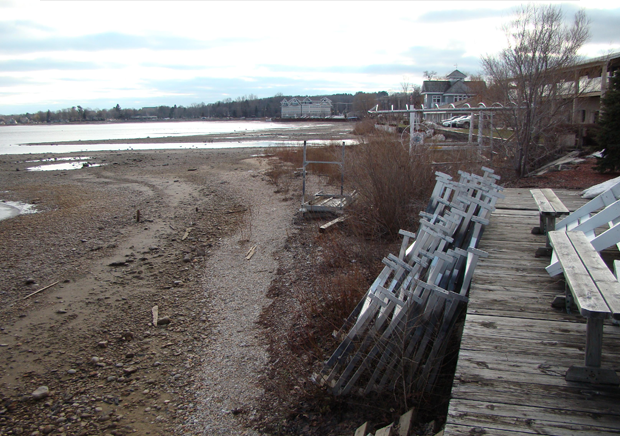 via NOAA
via NOAAThe main culprit for the receding lake level is the St. Clair River, a waterway that has been widened and deepened numerous times in the last century to provide a shipping channel between the upper and lower Great Lakes. The cumulative effect of human engineering and mother nature’s power is an oversized drain spout at the bottom of Huron.
The documentary Drain examines the current crisis at the Great Lakes, and the lessons learned from other inland oceans like the Aral Sea. Here the full video.